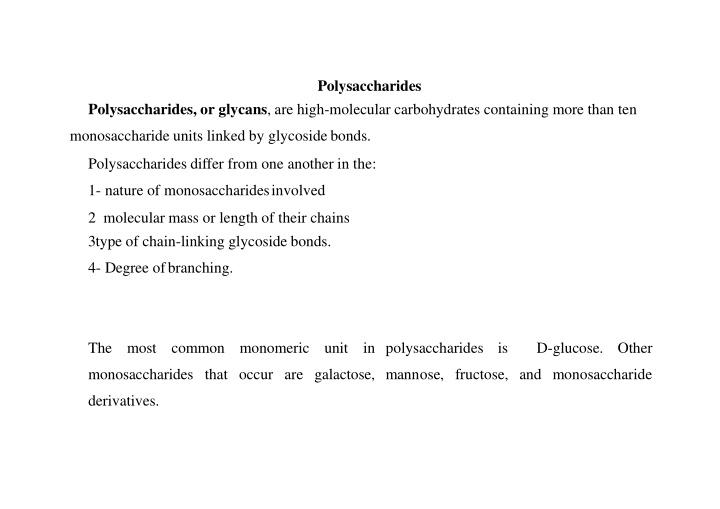
Understanding Polysaccharides: Types, Structures, and Properties
Explore the world of polysaccharides, high-molecular carbohydrates with unique properties, structures, and functions. Learn about homopolysaccharides (homoglycans) and heteropolysaccharides (heteroglycans), their distinct compositions, and roles in biological systems. Discover examples like starch, glycogen, and cellulose, and how these polysaccharides contribute to the diverse functions in cells and extracellular environments.
Download Presentation

Please find below an Image/Link to download the presentation.
The content on the website is provided AS IS for your information and personal use only. It may not be sold, licensed, or shared on other websites without obtaining consent from the author. If you encounter any issues during the download, it is possible that the publisher has removed the file from their server.
You are allowed to download the files provided on this website for personal or commercial use, subject to the condition that they are used lawfully. All files are the property of their respective owners.
The content on the website is provided AS IS for your information and personal use only. It may not be sold, licensed, or shared on other websites without obtaining consent from the author.
E N D
Presentation Transcript
Polysaccharides Polysaccharides, or glycans, are high-molecular carbohydrates containing more than ten monosaccharide units linked by glycosidebonds. Polysaccharides differ from one another in the: 1- nature of monosaccharidesinvolved 2 molecular mass or length of their chains 3type of chain-linking glycoside bonds. 4- Degree ofbranching. The most common monomeric unit in polysaccharides is D-glucose. Other monosaccharides that occur are galactose, mannose, fructose, and monosaccharide derivatives.
Distinguished are homopolysaccharides (homoglycans) built of only one type of monosaccharides and heteropolysaccharides (heteroglycans) composed of different types of monosaccharides. For example, starch is a homopolysaccharide, since it contains D-glucose only, while hyaluronic acid is a heteropolysaccharide, since it is made up of alternating units of D- glucuronic acid and N-acetyl-D-glucosamine. Polysaccharides are also subdivided into linear and branched species, according to the structural type of their polymeric chains. General properties of polysaccharides: Polysaccharides exhibit typical properties common to high-molecular compounds bearing polar groups. Thence, polysaccharides are hydrophilic; when placed in water, they swell (similar to fibrous proteins) and then dissolve partially to form colloidal solutions.
Polysaccharides are contained both inside the cells and in the extracellular matter. This signifies that the characteristic properties of polysaccharides show up under a variety of conditions. As a rule, neutral polysaccharides inside the cells are intended as reserve material (starch or glycogen). Acidic polysaccharides (hyaluronic acid and chondroitin sulphate) are commonly found in the extracellular space. Individualpolysaccharides: Homopolysaccharides: The structures for the most widespread homopolysaccharides are presented below and these homopolysaccharides contain only a single type of monomers:
Some examples: Starch is a homopolysaccharide found in plants; it consists of -amylose and amylopectin.
Glycogen is the major short-term storage polysaccharide found in all human and animal tissues. In small amounts, glycogen is also present in bacteria and plants. Glycogenstructure
Cellulose is a structural homopolysaccharide of plants. cellulose structure Heteropolysaccharides: These polysaccharides are contain two or more different kinds of monomer units and the structures are presented below:
They all are found in the extracellular space in the tissues of multicellular animals, the extracellular matrix, also called ground substance, which holds the cells together and provides a porous pathway for the diffusion of nutrients and oxygen to individual cells. Heteromacromolecules are referred to as proteoglycans or glucosamine proteoglycans.
Some examples: Hyaluronic acid is linear heteropolysaccharide. It has the greatest molecular mass among the heteropolysaccharides. It serves as the biological cement filling the intercellular space. Hyaluronic acid
Chondroitin sulphates are the most abundant acidic heteropolysaccharides in human and animal tissues. They occur in skin, bone tissue, cartilage, etc. Chondroitinsulphates
Heparin is distinct from other acidic heteropolysaccharides, they are not structural components for the extracellular material. In blood heparin is noncovalently bound to specific proteins. The complex of heparin with glycoprotein of plasma exhibits an anticoagulatory activity, while the complex of heparin with the enzyme lipoprotein lipase is capable of cleaving lipids found in the blood as chylomicrons. Heparin
Biological functions of polysaccharides: The essential functions of polysaccharides are: energetic supportive protective colligative (structural) hydroosmotic and ion-regulating cofactor. Digestive mechanism for carbohydrates: The digestion of carbohydrates starts in the oral cavity, mainly through the agencyof salivary - amylase. Certain scientists believe that another enzyme, maltase, is also present in the saliva.
-Amylase is composed of a single polypeptide chain; it is acts on the glycoside bonds and hydrolyzing the glycoside bonds of these polysaccharides. By the action of -amylase, the polysaccharides are split into a limit- dextrin, maltose, and a small amount of glucose. Maltose is formed as the end product. Disaccharides undergo hydrolysis and the monosaccharides formed are immediatelly absorbed. -Oligosaccharidases includemaltase, sucrase,lactase: Maltase 2 glucose Maltose + H2O Sucrase Sucrose + H2O glucose + fructose Lactase glucose + galactose Lactose + H2O The end products of carbohydrate digestion are monosaccharides, mostly glucose, fructose, and galactose.




















